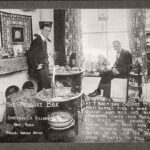
Bohemianism: An Artistic Movement
The Bohemian Movement, also known as Bohemianism, was a cultural and artistic movement that emerged in the mid-19th century in Paris, France. It was a lifestyle and philosophy that rejected mainstream societal norms and embraced individual freedom, creativity, and unconventionality.
The Bohemian lifestyle was characterized by unconventional living arrangements, such as communal living spaces and artistic salons. They rejected the traditional values of middle-class society and instead pursued artistic and intellectual endeavors. This often led to a rejection of materialism and a focus on living simply.
Bohemians were known for their unconventional fashion choices, which included loose-fitting clothing, long hair, and colorful scarves. They often wore items that were considered inappropriate or scandalous, such as men wearing women’s clothing or women wearing pants.
The Bohemian Movement was deeply influenced by the Romantic Movement, which emphasized individualism, emotion, and nature. Many Bohemians also drew inspiration from Eastern religions and philosophies, such as Buddhism and Taoism.
The movement attracted artists, writers, and intellectuals who were drawn to the Bohemian lifestyle. Many famous artists, such as Vincent van Gogh, Henri de Toulouse-Lautrec, and Edgar Degas, were associated with the movement. The literary figures of the time, including Charles Baudelaire and Arthur Rimbaud, were also heavily influenced by Bohemianism.
Bohemianism spread beyond Paris and influenced other European cities, such as London and Berlin. In the United States, the Beat Generation of the 1950s and 60s was heavily influenced by the Bohemian Movement.
While the Bohemian Movement may seem like a historical relic, its influence can still be seen today in various forms of counterculture. The rejection of societal norms and the embrace of individualism and creativity are still important values for many people.
In conclusion, the Bohemian Movement was a cultural and artistic movement that rejected mainstream societal norms and embraced individual freedom, creativity, and unconventionality. Its influence can still be felt today in various forms of counterculture.




